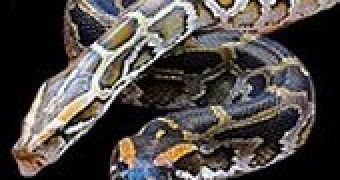A computer tomography scan and a magnetic resonance imaging were realized on a 5 kg Python molurus bivittatus. Henrik Lauridsen and Kasper Hansen, from the Department of Zoophysiology and MR Research Center at Aarhus University in Denmark, found out what is going on inside the python's organs an hour after he had swallowed a rat, using contrast agents.
These animals, native from Southeast Asia, are among the largest snakes on the planet. They can reach 7 meters or more in length and can weight up to 90 kg. These reptiles stay on trees when young, and when their weight and size increase, they tend to remain on the ground. They are also excellent swimmers and can stay underwater for as long as 30 minutes.
They survive mainly on small mammals and birds but they have the ability of swallowing larger preys, the size of a deer. Their poor eye-sight forces them to use the chemical receptors on their tongues and the heat-sensors along their jaws. This threatened species kills by constriction, and can swallow their food whole, thanks to the stretchy ligaments in their jaws.
The experiment made by the Danish scientists focused on the 132 hours rat's digestion. They noticed that during the whole process, the snakes gall bladder decreased, the intestines expanded and the heart's size increased by 25 percent. As pythons can go for long periods of time without eating, their intestinal system must start rapidly, thus the heart's enlargement.
This new technique allowed scientists to see inside an animal without dissecting it. A classic dissection can lead to misinterpretations and changes in the animal's physical condition, like the lungs collapse when a turtle shell is opened. This study was presented at the annual meeting of the Society for Experimental Biology in Prague, Czech Republic.

 14 DAY TRIAL //
14 DAY TRIAL //